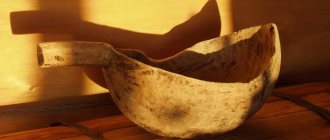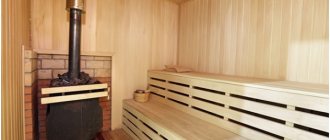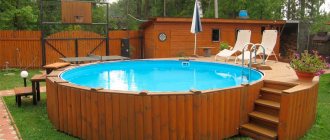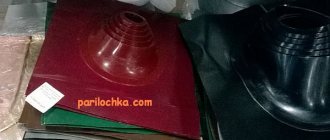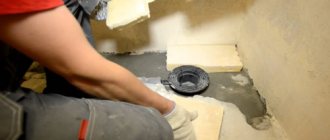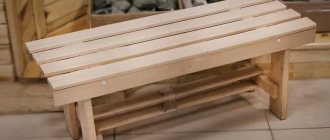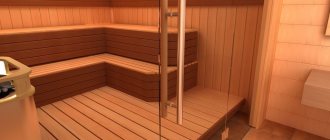A wooden lampshade for a bathhouse can serve not only as a wall item necessary to provide room lighting, but as a decor, providing aesthetic value for vacationers. Thanks to the bath lamp, the socket and the lighting lamp are protected from moisture and mechanical stress. What are the advantages, types and how to make a lamp with your own hands you will learn from this article from Heart of ECO .
Material and tools for making a lampshade for the steam room
It is better to have a special electric tool. This is a hand router and jigsaw. If they are not there, then you will have to make a wooden lampshade using simple hand tools. True, the quality of the product may suffer and the manufacturing process itself will be significantly lengthened. However, the design of the lampshade (or grille) is not so complex that our diffusing screen would turn out to be too unsightly.
Any wood that does not emit resin will do. Linden, birch, alder, black alder, maple, aspen - this is the material that is widely used when interior finishing of a bathhouse or sauna is made. Therefore, as mentioned above, there should not be a shortage of necessary wood waste.
If the bathhouse has already been built, but there is no necessary waste, you will have to buy it in the store.
- For round lintels, you can take wooden dowels ø 12 mm and 1 meter long.
- For rectangular jumpers - appropriate slats.
- A planed board or furniture board 20 mm thick is suitable for making lower and upper holders.
To fasten the entire structure, you will need thin nails (preferably brass finishing nails for connecting wooden parts).
Tool
- Manual electric router with a set of cutters;
- Electric jigsaw;
- Electric drill (or screwdriver) with a set of drill bits for wood;
- Manual circular;
- Wood hacksaw;
- Hammer;
- Ruler;
- Protractor or square with an angular scale;
- Abrasive sandpaper.
Advantages
Due to the fact that the product is used in unusual conditions, the following requirements apply to its manufacture and use:
- Reliability. The lamp is made of durable material so that when used in conditions of high temperatures and high humidity it does not burst, thereby injuring people.
- Environmental Safety. As a result of the influence of high temperatures, the product may release harmful fumes into the environment from heating the plastic. In this regard, the lampshade must be made of wood or substances that do not contain harmful artificial materials.
- Fire resistance. If wooden products are used as a lamp, it is coated with a special substance to prevent fire. It is also permissible to use non-flammable substances as raw materials for the manufacture of lampshades.
- Moisture resistance and durability. It is prohibited to use fabric or paper as a manufacturing material.
Important! Wood products typically use LED fluorescent lamps for lighting. They do not create fire hazards.
If we talk about the advantages of a wooden product, we can name the following:
- complete environmental friendliness - wood material does not emit harmful substances during its use, but has a beneficial effect on a person’s condition, on his mental and emotional mood;
- wood material is very malleable, which is why it is possible to make lamps of any shape and complexity;
- using lampshades, you give the room a cozy, homely look;
- since there are many types of wood, each of them is used to realize various fantasies of their owner;
- wood can be perfectly combined with other materials.
How to make a lampshade for a bathhouse with your own hands
Below are two options for a corner diffuser wooden grille for a lamp
in a steamy room.
Their difference lies in the different design of internal jumpers. So, in the first example they are only round jumpers ( item 4
), and in the second - a combination of round and rectangular.
Accordingly, the holders ( item 5
) are processed in such a way that all the parts can be joined when assembling the lampshade.
The radii and curves in the wooden parts are processed with a router, and the holders are cut out using an electric jigsaw along a pre-drawn contour.
Blind round holes are drilled to a depth of 5 mm using a ø12 mm drill with a centering tip. Longitudinal grooves 15 mm long can be made by drilling two holes and using a chisel to remove the jumper between them.
Two extreme jumpers ( item 3
), as well as the upper and lower holder, are the same for both grille options.
Note:
The overall dimensions of the dissipating grilles are selected in such a way that it is possible to cover the heat-resistant wall lamp SAS21060 from the Finnish manufacturer of bath equipment “Harvia”.
The first version of the scattering grating
This is the simplest example of making a lampshade with your own hands.
The internal lintels are a simple geometric option - round dowels ø12 mm and 270 mm long. You can, of course, make them yourself, but without special equipment this is quite problematic.
Drawing of holder and rectangular jumper
The second option for making a lampshade for a steam room
The length of the central longitudinal groove for this grille option is equal to the sum of the width of the rectangular jumpers inserted into them ( items 1 and 2
) and is 115 mm, that is, 23 x 5 = 115.
Drawing of holder and rectangular jumpers
In order for scattered light to pass between them, their edges are milled to a depth of 2.5 mm, and in the two outer jumpers they are made on one side, and in the three inner ones they are made on both sides. Thus, a gap of 5 mm is obtained between them.
Assembly of both versions of the scattering grid is carried out using thin nails, which are driven into both outer and one or two central jumpers. This is quite enough to ensure the necessary rigidity of the entire product.
First, we do not drive the nail in completely, then we bite off the head with pliers and drive the remaining part flush with the surface of the holder. Without a cap and slightly recessed into the body of the wood, the carnation will be almost invisible to the naked eye.
Proper lighting in the steam room is one of the most important conditions for a comfortable stay in the bath. By making a wooden lampshade with our own hands, we will not only receive satisfaction from the work done, but will also create soft and unobtrusive lighting in the most important bath room - the steam room.
LED lamp for baths and saunas:
Dear friends! If it’s not difficult, share it on these social networks with your friends. Thank you!
Lamps: which ones can be installed, which is better
In addition to choosing the shape of the lampshade, you also need to decide what kind of lamps you will put in it.
In the bathhouse, 60-watt incandescent lamps , LED lamps and strips, as well as halogen and fiber-optic light sources are acceptable.
Bath light bulbs: incandescent lamps
In the old days, there simply weren’t any other options.
However, this variety is very fragile and sensitive not only to mechanical stress , but also to sudden temperature changes , for example, when water gets on the flask.
Therefore, they are dangerous by the very presence of glass and a red-hot spiral. Another factor not in their favor is the voltage - 220 volts can kill a person if the unexpected happens. Although there are 36 volt light bulbs, they can work through a transformer.
protect yourself from electric shock by installing an RCD (more details in this and this article on our website). In this case, the current will turn off so quickly that it will not have time to harm a person. And the lampshade with a mesh should protect from mechanical destruction .
CONCLUSION: you can use such light bulbs for a bath not only in dry rooms, but also in wet ones, including a steam room. But taking into account protective measures. In addition, this is the most budget-friendly type.
Fiber optic
Optical fiber is not cheap, but if this is not a question, then it can be used to illuminate a relaxation room, a steam room, and a swimming pool.
On sale you will find two types of cables - with side and end glow. The difference is clear: in the former, the light spreads from the entire surface of the cable, while in the latter, the cable itself does not glow, but a bright light shines from the cut at its end. A cable with a side glow may have internal notches that make the glow inhomogeneous and chaotic.
Both varieties are suitable for installation in bathhouses.
The lamp structure includes a projector and cables of the required length.
ATTENTION! If you intend to use fiber optics in the steam room, then the projector must be located outside it, although not too far, literally behind the wall.
The projector can be equipped with crystals and discs of different colors.
LEDs
In principle, if you are interested in this topic, you can look at a large material dedicated only to LEDs for baths.
Here we will describe them briefly. LEDs can be a strip or a lamp. The latter is screwed into a regular socket; the mains voltage can be 220 or 12 V.
To power 12-volt LEDs, either a step-down transformer or a power supply . If a power supply is used, it must have galvanic isolation , which ensures that even in the event of a malfunction, 220 V will not flow to the consumer.
LEDs are sensitive to two factors - current fluctuations in the network and high temperature (above 65 degrees on the chip). This shortens their service life.
Installing them in a steam room is undesirable, but beneficial - low voltage, low energy consumption. Therefore, the high temperature trade-off is usually resolved by mounting the LEDs low in height (where the temperature is lower). If these are tapes, then they are laid under and behind the shelf.
IMPORTANT! Tapes used in wet rooms must have a high degree of moisture protection - placed in a transparent sealed tube, at a minimum. As a maximum, transparent silicone is filled inside the tube.
How to make a lamp for a bathhouse with your own hands
Making a lighting system for a sauna steam room is a fairly creative process, so there are no strict schemes or restrictions by which the design, shape and general structure of the lamp is selected. But do not forget that the lighting system is planned for a room in which the air temperature and humidity can reach 80 o and 90%, respectively. Therefore, before you start making a lamp for the steam room with your own hands, let’s clarify some design requirements:
- The best material for making the frame and lampshade is linden or aspen wood. Anything will do, you can use vines, profiled planks, trimmings of slats and lining, and even tree branches;
- You cannot make a bath lamp from plastic or paint wood with non-heat-resistant varnishes and paints;
- The light bulb socket should only be ceramic, no ebonite or heat-resistant plastic;
- It is best to provide a protective shade in the design of a bath lamp;
- The external lampshade covering the light source can be of any shape and size, but it must be attached to the wall of the steam room using screws and nails, or any other mechanical fastener, no glue or wooden pins.
A primitive modification of the standard cartridge allows you to avoid the ingress of microdroplets of water during the process of washing and cleaning the steam room and the entire sauna room.
As a basis for the lighting system in the steam room, it is better to take the popular “Linder”, which is resistant to moisture and high temperature.
Required Tools
The more complex the design of the lampshade and the entire lamp, the more tools and devices will be required for its manufacture. A simple, but at the same time quite nice and convenient version of a wooden sconce for the wall of a steam room can be made using a simple set of tools:
- A set of drawing patterns, rulers, copiers, - any marking devices that help transfer the contours from the drawing to wooden boards and planks;
- Electric drill, hand or machine;
- Electric sharpener with roughing and polishing wheel;
- Hand hacksaw for wood with fine teeth;
- A set of sandpaper with different grain sizes;
- Hammer and wallpaper nails.
In some cases, it is necessary to make additional devices and fixing frames on which the body of the lampshade and the supporting frame can be assembled and knocked down. Therefore, when planning to make a lamp for a steam room with your own hands, you need to at least think through the stages of its assembly and, if possible, prepare in advance the necessary equipment, at least a clamp, tape and steel or copper wire.
The Harvia lamp is used for baths and steam rooms, the best option for basket-type lampshades
Materials for making lamps
It is clear that the main material from which lighting systems for baths are made has been and remains the wood of the species that are most resistant to moisture and high temperatures. With the possible exception of red cedar, sandalwood, and ash, the texture and grain pattern of other types of wood is not particularly expressive or beautiful. Even aspen or linden do not look very interesting.
The exception is the texture of larch, but using coniferous lining to make a bathhouse lamp with your own hands from wood is only possible for auxiliary rooms, for example, a dressing room or a rest room. It is better not to use larch in the steam room, or, before trying to make a body of the workpiece, you need to bleach and remove the resin with a mixture of alcohol and acetone, then with an aqueous solution of ammonia.
A universal lampshade option for any bath room
Recently, the use of Tibetan or Altai salt has become extremely popular. Inserts made of salt plates and blocks are used as a scattering screen, and at the same time a device for disinfecting and improving the atmosphere in the bathhouse.
LED
LED lighting has a number of undeniable advantages.
- Economical (lower energy consumption compared to incandescent light bulbs)
- Safety (sealed models, low voltage)
- Light quality (bright light)
- Variety of glow colors (white, green, red, etc.)
Incandescent lamps
The most popular lighting for a bathhouse is ordinary light bulbs. It is important to understand that they must be used in conjunction with special sealed lampshades and sauna lampshades.
If incandescent lamps with a power of up to 60 watts have the appropriate degree of protection, then they are not dangerous even when exposed to liquid.
Halogen
It has a number of undeniable advantages.
- Economical (lower energy consumption compared to incandescent light bulbs)
- Safety (lighting is sealed)
DIY bathhouse lamps: photo
Despite the limited choice of material, there is a fairly large number of various schemes for constructing a lamp for a bathhouse. It all depends on imagination and the desire to spend time and effort on painstakingly cutting out the details of the lighting system.
Lighting in the waiting room and rest room
Of course, the selection of design and location of light sources in the bathhouse must correspond to the purpose of the room. For example, for a dressing room or washing compartment of a bathhouse, you can use a compact and stylish lamp in the form of a wall sconce.
The most convenient models for steam rooms
For a more spacious bathhouse rest room with high ceilings, a ceiling light or even a chandelier would be appropriate. To ensure that the lighting system fits organically into the design of the room, you can use elements of Country style.
Despite the rough appearance, chandeliers cut from boards with wooden shades - lanterns - look quite stylish and appropriate, and in addition, three lamps under the ceiling provide more comfortable and safe lighting in a large bathhouse than a pair of wall lamps.
One of the unusual design options for a ceiling lamp is shown in the photo below.
Lamp for the relaxation room of the bath
This lamp can be installed in any room of the bathhouse, even in the steam room. If you choose the right branching shape and cut the lower part of the wood with the bark, then it is quite possible to achieve a very realistic imitation of deer antlers.
Lighting options in the steam room
If you take on making a lamp for a bathhouse with your own hands, then it is best to choose models that are simpler in design. For large steam rooms, you can use frame lattice structures that completely cover the corner from the shelves to the ceiling.
It turns out quite stylish, especially in combination with LED lighting
For relatively small steam rooms, small corner models with a lattice lampshade will be more convenient. Such designs are quite simple to manufacture and do not require much effort to install inside a bathhouse.
How to choose
Heat-resistant LED strip, protection class IP67
There are several main points that need to be taken into account when organizing lighting in a bathhouse. General recommendations:
- The material of the lampshades is chosen matte to obtain soft diffused light;
- portable devices cannot be used, especially if their power is connected directly to electricity;
- lamps with daylight or containing mercury are immediately excluded from the list of possible options;
- LED strips (separate switch) are suitable as emergency lighting for the steam room in the bathhouse;
- purchase devices only from trusted stores;
- discounts and promotions are the first sign of a low-quality product.
Lighting fixtures in a bathhouse are a source of increased danger. When purchasing cheap and ill-conceived options, the risk of breakdowns and fires increases.
Do-it-yourself wooden lamps for a bath
Many of the above models can be made, so to speak, on the knee, so corner lamps are best suited for the first experience of making a lantern for a bathhouse with your own hands.
Lamp – half-barrel for steam room
It often happens that when installing a lamp shade on the wall of a steam room, it becomes necessary to cut something or trim the wooden frame. Repeated application of protective varnish leads to the appearance of stains and streaks.
Grille-lampshade
There is probably no simpler design for a wall lantern than a wooden lampshade screen. To make a lamp with your own hands, you will need two linden boards 12-20 mm thick and 100-120 mm wide. Structurally, the lampshade for lighting a bathhouse is a rounded grille assembled from vertical slats and two wooden arches.
Initially, we transfer the contours of the arc onto the surface of the linden workpiece
Next, using a band saw or a regular jigsaw, we cut out the contours of the arcs, grind the workpieces on a sharpener and manually remove the sharp edges on the slats with emery cloth.
The next step is to place the arcs in a clamp and glue the slats
Glue is needed only to temporarily fix the lattice elements to the frame. For the humid and hot atmosphere of the steam room, the adhesive connection turns out to be unreliable, so each strip must be secured either with wallpaper nails or staples from a construction or furniture stapler. In the dim lighting of the steam room, the fasteners will be invisible, so the design of the lampshade will not be affected.
All that remains is to sand the surface of the grille again and install it on the lamp. If desired, one of the arcs can be made larger in diameter, and the thick laths of the sheathing can be replaced with thinner ones. The result will be a cone-shaped, very beautiful shape, however, such a lamp can only be fixed in the corner of the steam room.
Scattering screen
The use of bright light sources in a steam room is, on the one hand, convenient, but on the other hand, it can be very irritating to the eyes. You can use a classic glass screen, cap or milky white polycarbonate, but it is best to make a light diffuser from Tibetan salt.
To assemble a screen from salt, you can use any ready-made lamp for a steam room; you just need to additionally fill a frame from slats to fix the salt plates.
This screen should be installed in the hottest place in the bathhouse.
The second option for equipping a bathhouse is considered more complex, but at the same time interesting. First of all, you will need to make a lampshade grille according to the classical design, but the vertical slats should be thinner, it is better to make them from steel wire.
All that remains is to place pieces of Altai salt inside the lamp, and the screen for the steam room or any other room in the bathhouse is ready.
How to attach and install
First of all, it is necessary to prepare the frame and the necessary elements attaching to it. The frame of the housing must be of such a volume that the lighting device can fit inside it. Then the back wall is prepared. It is necessary to calculate the distance between the frame and the wall. The frame should be wrapped in foil. This is necessary to provide additional reflection to enhance the rays. You can also use reflective tape instead of foil. At the last stage of preparation, it is necessary to fasten it with hardware, but this should be hidden from the eyes of the bathhouse visitor to give a more aesthetic appearance.
Weaving a lampshade from a wicker for a bath
It is clear that the manufacture of a protective cap for a lamp is not limited only to carpentry grilles and screens. With the same success, the lampshade can be woven from ordinary willow vine. In this case, it is not even necessary to know how to knit a vine; it is enough to lay thin barked rods between wooden slats.
The frame of the bath lamp is made of two half-arches, the curved surface is sewn up with thick wicker rods with a pitch of no more than 40 mm. The vines are placed between the racks in their raw form and dried at room temperature.
A wicker lamp for a bath can be made from any natural material that is soft and resistant to moisture and high air temperatures in the bath and steam room.
Wicker screen option
Basic requirements for steam room lighting:
- Resistant to high temperatures according to conditions of use.
- Good moisture resistance. Must comply with terms of use. The degree of protection against water is at least IP65.
- Safety. A 12-volt voltage and a high level of external protection are required.
- Quality: Light should be soft, diffused and dim.
Technical requirements for the installation of lighting in specific wet rooms are set out in GOST R 50571.11-96 in section No. 701.
Decorating the lamp
It is not necessary to make the lighting for the bathhouse from scratch; it is easier and faster to modify a ready-made lantern. For example, you can decorate a finished lampshade with overlay strips made of birch or linden veneer.
The yellow-white texture of linden wood looks boring, so wooden cases and slats are treated with toners, a pattern is applied that imitates fibers, for example, rosewood or ash, and they are opened with acrylic varnishes.
If the lamp will be located in a bathhouse or steam room in close proximity to a pipe or stove, then it is best to use high-quality silicone oils or varnish coatings. Otherwise, over time, the body of the flashlight will turn yellow and lose its appearance.
What can you buy in the store?
hundreds of several thousand rublesSome models are clearly not intended to be placed in a steam room at all
We repeat - for a steam room you need a simple waterproof lamp with a protection class of at least IP44. For tightness, it has a rubber or silicone gasket. The base will not be made of wood or plastic. The transparent or matte part, if it is made of plastic, then some kind of temperature guarantees should be given for it (check with the seller).
If you don’t want to deal with the entire assortment that will be offered to you in the store, first decide on a budget - Russian lamps for a steam room in a bathhouse are several times cheaper than foreign ones. Some of them are made as analogues of the most popular foreign models.
ATTENTION! Among other things, there are lampshades made of Himalayan salt. We do not recommend purchasing them for a Russian steam room - it is still the same salt as in a salt shaker, and high humidity will corrode it!
Material and tools for making a lampshade for the steam room
It is better to have a special electric tool. This is a hand router and jigsaw. If they are not there, then you will have to make a wooden lampshade using simple hand tools. True, the quality of the product may suffer and the manufacturing process itself will be significantly lengthened. However, the design of the lampshade (or grille) is not so complex that our diffusing screen would turn out to be too unsightly.
Any wood that does not emit resin will do. Linden, birch, alder, black alder, maple, aspen - this is the material that is widely used when interior finishing of a bathhouse or sauna is made. Therefore, as mentioned above, there should not be a shortage of necessary wood waste.
If the bathhouse has already been built, but there is no necessary waste, you will have to buy it in the store.
- For round lintels, you can take wooden dowels ø 12 mm and 1 meter long.
- For rectangular jumpers - appropriate slats.
- A planed board or furniture board 20 mm thick is suitable for making lower and upper holders.
To fasten the entire structure, you will need thin nails (preferably brass finishing nails for connecting wooden parts).
Tool
- Manual electric router with a set of cutters;
- Electric jigsaw;
- Electric drill (or screwdriver) with a set of drill bits for wood;
- Manual circular;
- Wood hacksaw;
- Hammer;
- Ruler;
- Protractor or square with an angular scale;
- Abrasive sandpaper.
Material
In principle, the material can be stainless metal or glass, but we are talking about a bathhouse, or rather, even a steam room, so metal can be immediately rejected, because it will heat up and can burn. Glass…
Glass
Using glass in a steam room and washing room is quite acceptable if we are talking about a matte lampshade that hermetically protects the light bulb inside from water. Actually, there is not much choice here - you need a translucent material that transmits light well. Plastic is not suitable for a steam room (we note in parentheses that it is not suitable even if it is produced by Harvia).
ATTENTION! However, we are not talking about decorative lampshades, which also have a protective function. Only the cap that directly covers the light bulb can be glass.
Decorative parts are made from other materials, which are discussed below.
Wooden
In this case, wood should be considered the optimal material, given that the vast majority of owners choose it as a finishing material. So, in a log house or in a clapboard-lined steam room, a wooden structure will look best.
The tree differs by wood species . Of course, there is not always a choice, but listen to our words:
ADVICE! Do not use coniferous species when making a wooden lampshade for a bathhouse, because lamps, in addition to light, also emit heat, and coniferous ones have the unpleasant property of releasing resin when the temperature rises.
Any deciduous tree will do . Only if you are going to do something delicate, then softer species, such as linden or aspen, are suitable, and any tree is suitable for a more simple design.
With Himalayan salt
Himalayan salt in this case is used as a light-diffusing screen. This is possible both when choosing plates from it, and when filling the container with lump material.
Rock salt , of course, is harder than table salt, but its composition is approximately the same (with the exception of various additives such as iron, which gives it a reddish tint, and other salts - for example, sulfates, borates). What this means, first of all, is that under the influence of moisture and heat, halite (the name of the mineral is the same as “rock salt”) will slowly but steadily dissolve .
Regarding the fact that the effect of salt is healing... Well, NaCl (sodium chlorine) there is exactly the same as in a salt shaker. Other supplements are somehow not necessarily useful, like vitamins. Why do you need sulfur or boron salts? Microelements - if they are really released as actively as they say - will not interfere, we will not argue.
Salt plates or irregularly shaped pieces are very beautiful, especially when light filters through them. So the main argument in favor of choosing such a lampshade, after all, will be beauty.
How to make a lampshade for a bathhouse with your own hands
Below are two options for a corner diffuser wooden grille for a lamp
in a steamy room.
Their difference lies in the different design of internal jumpers. So, in the first example they are only round jumpers ( item 4
), and in the second - a combination of round and rectangular.
Accordingly, the holders ( item 5
) are processed in such a way that all the parts can be joined when assembling the lampshade.
The radii and curves in the wooden parts are processed with a router, and the holders are cut out using an electric jigsaw along a pre-drawn contour.
Blind round holes are drilled to a depth of 5 mm using a ø12 mm drill with a centering tip. Longitudinal grooves 15 mm long can be made by drilling two holes and using a chisel to remove the jumper between them.
Two extreme jumpers ( item 3
), as well as the upper and lower holder, are the same for both grille options.
Note:
The overall dimensions of the dissipating grilles are selected in such a way that it is possible to cover the heat-resistant wall lamp SAS21060 from the Finnish manufacturer of bath equipment “Harvia”.
The first version of the scattering grating
This is the simplest example of making a lampshade with your own hands.
The internal lintels are a simple geometric option - round dowels ø12 mm and 270 mm long. You can, of course, make them yourself, but without special equipment this is quite problematic.
Drawing of holder and rectangular jumper
The second option for making a lampshade for a steam room
The length of the central longitudinal groove for this grille option is equal to the sum of the width of the rectangular jumpers inserted into them ( items 1 and 2
) and is 115 mm, that is, 23 x 5 = 115.
In the rest room
The relaxation room is the very place in the bathhouse where you can show your imagination in the process of arranging lighting.
There are no strict requirements for this room, so the number and type of lighting fixtures depends only on the taste of the owners.
It is best to place several light sources at different levels. The presence of overhead lighting, sconces, as well as illumination of some areas will provide the ability to choose the level of light.
You can give in to impulse and realize all your wildest fantasies regarding bath lighting. Here you can install colored lighting, lighting in the form of stars, or even create the feeling that you are in a planetarium.
Information. It is recommended to choose not too bright lighting for the rest room, since it is the very place where you can relax and unwind.
